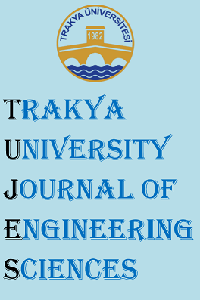GEREKSİNİM MÜHENDİSLİĞİ BİLGİ ALANLARININ GELENEKSEL VE ÇEVİK YAZILIM YÖNTEMLERİ AÇISINDAN KARIŞLAŞTIRILMASI
Bir yazılım projesi uygularken dikkat edilmesi gereken önemli noktalardan biri gereksinimlerin başarılı bir şekilde yönetimidir. Yazılımın başarısı, gereksinimlerin doğruluğuna ve eksiksizliğine bağlıdır. Mevcut metodolojilerin olumlu ve olumsuz yönlerini, avantajlarını ve dezavantajlarını bilmek gerçekleştirilecek projeler için en uygun metodolojinin seçilmesine yardımcı olacaktır. Proje için kaynaklara, bağlama ve diğer unsurlara göre en uygun yaklaşımı seçmek de proje başarımını artırır.
Anahtar Kelimeler:
Gereksinim mühendisliği, Geleneksel yazılım geliştirme yöntemleri, Çevik yazılım geliştirme yöntemleri, Çevik ve geleneksel süreçlerin karşılaştırılması
COMPARISON OF REQUIREMENTS ENGINEERING KNOWLEDGE AREAS IN TERMS OF TRADITIONAL AND AGILE SOFTWARE METHODS
One of the important points to be considered when implementing a software project is the successful management of the requirements. The success of the software depends on the accuracy and completeness of the requirements. Knowing the positive and negative aspects, advantages and disadvantages of the existing methodologies helps for selecting the appropriate methodology and choosing the appropriate approach to the situation and the project in this direction will increase the probability of success of the project. Although there is a lot of research in the literature about the traditional and agile approaches which are the main trends of software development approaches, the publications made in specific for requirements engineering process are limited. In this study, the necessary engineering applications in traditional and agile methodology approaches are evaluated to assist in the selection of methodology.
Keywords:
Requirements engineering, Traditional software development methods, Agile software development methods, Agile and traditional comparison,
___
- Babok v3: A guide to business analysis body of knowledge. (2015). Toronto: IIBA.
- BATOOL, A., MOTLA, Y.H., HAMID, B., ASGHAR, S., RIAZ, M.N., MUKHTAR, M., AHMED, Comparative study of traditional requirements engineering and Agile requirements engineering., 15th (ICACT), 1006-1014, 2013
- BOSE S., KURHEKAR M., GHOSHAL I. (2014, October) Agile Methodology in Requirements Engineering, Retrieved from: http://www.infosys.com/research/publica-tions/agilerequirements-engineering.pdf
- BOURQUE, P., & FAIRLEY, R. E. (2014). SWEBOK: Guide to the software engineering body of knowledge. Los Alamitos, CA: IEEE Computer Society.
- BOYER, J., & MILI, H. (2014). Agile Business Rule Development Process, Architecture, and JRules Examples. Berlin: Springer Berlin.
- BROOKS. (1987). No Silver Bullet Essence and Accidents of Software Engineering. Computer, 20(4), 10-19.
- DECARLO, D. (2004). EXtreme project management: Using leadership, principles, and tools to deliver value in the face of volatility. San Francisco, CA: Jossey-Bass.
- ELSHANDIDY, H. & MAZEN, S., Agile and Traditional Requirements Engineering: A Survey, International Journal of Scientific & Engineering Research, 4 (9), 2013
- GRIFFITHS, M. (2015). PMI-ACP exam prep: Rapid learning to pass the PMI Agile Certified Practitioner (PMI-ACP) exam. Minnetonka, MN: RMC Publications.
- HASTLE, S., WOJEWODA S. (2015, October 4). Standish Group 2015 Chaos Report - Q&A with Jennifer Lynch. InfoQ. Retrieved from https://www.infoq.com/articles/standish-chaos-2015
- IEEE recommended practice for software requirements specifications. (1998). New York: IEEE.Industry implementation of International Standard ISO / 1995: (ISO/IEC 12207) standard for information technology: Software life cycle processes. (1998). New York: Institute of Electrical and Electronics Engineers.
- LAWRENCE, B., WIEGERS, K., and EBERT, C. "The top risk of requirements engineering," in IEEE Software, vol. 18, no. 6, pp. 62-63, Nov.-Dec. 2001.
- LUCIA A., QUSEF A., Requirements Engineering in Agile Software Development, Journal Of Emergıng Technologıes In Web Intellıgence, 2, (3), Ağustos 2010.Manifesto for Agile Software Development, Agile Manifesto (2001). Retrieved from https://agilemanifesto.org/
- MORE N., SAPRE B.S., CHAWAN P.M., An Insight into the Importance of Requirements Engineering, IJIC, ,1 (2), 2011.
- NORTON D., Agile Estimation and Planning Is Moving From a Dictatorship to a Democracy, Gartner, 2008.
- PALMQUIST M.S., LAPHAM M.A., MILLER S., CHICK T, OZKAYA I., Parallel Worlds: Agile and Waterfall Differences and Similarities, CMU/SEI-2013-TN-021, Ekim 2013.
- PATTON, J., ECONOMY, P., FOWLER, M., COOPER, A., & CAGAN, M. (2014). User story mapping. Beijing: OReilly.
- PROCACCINO, J. D., VERNER, J. M., OVERMYER, S. P., & Darter, M. E. (2002). Case study: Factors for early prediction of software development success. Information and Software Technology, 44(1), 53-62.
- RUBIN, K. S. (2013). Essential Scrum: A practical guide to the most popular agile process. Upper Saddle River, NJ: Addison-Wesley.
- SEDA, G. Y., TARHAN, A., Çevik Süreç ile Kıyaslamaya Temel Olarak Artırımsal Sürecin Nicel Analizi: Bir Durum Çalışması, 2. Yazılım Kalitesi ve Yazılım Geliştirme Araçları Sempozyumu, 2010.
- SHENHAR, A., & DVIR, D. (2007). Reinventing project management: The diamond approach to successful growth and innovation. Boston, MA: Harvard Business School Press.
- SHINDE L.K., TANGDE Y.S., KULKARNI R.P. Traditional vs. Modern Software Engineering - An Overview of Similarities and Differences. Advances in Computational Research, 7 (1), 187-190, 2015.
- SILLITTI, A., CESCHI, M., RUSSO, B., & SUCCI, G. (n.d.). Managing Uncertainty in Requirements: A Survey in Documentation-Driven and Agile Companies. 11th IEEE International Software Metrics Symposium (METRICS05). doi:10.1109/metrics.2005.29
- Software development process (2018, October), Wikipedia (2018), Retrieved from: https://en.wikipedia.org/wiki/Software_development_process
- Software Requirements Engineering: What, Why, Who, When ... (n.d.). Retrieved from http://westfallteam.com/Papers/The_Why_What_Who_When_and_How_Of_Software_Requirements.pdf
- SOMMERVILLE I, and SAWYER, P. Requirements Engineering, John Wiley & Sons, 1997.
- STOICA, M., MIRCEA, M., & GHILIC-MICU, B. (2013). Software Development: Agile vs. Traditional. Informatica Economica, 17(4/2013), 64-76. doi:10.12948/issn14531305/17.4.2013.06
- Try QA, What are the Software Development Models (2018, October), Retrieved from: http://istqbexamcertification.com/whatare-the-software-development-models/.
- Tutorialspoint, SDLC – Overview (2018, October) , Retrieved from: http://www.tutorialspoint.com/sdlc/sdlc_overview.htm
- WITHALL, S. (2007). Software requirements patterns. Erscheinungsort nicht ermittelbar: Microsoft Press.
- WYSOCKI, R. K., JUNIOR, R. B., & CRANE, D. (2007). Effective project management: How to plan, manage, and deliver projects on time and within budget. (Fourth Edition) New York: John Wiley.
- ISSN: 2147-0308
- Yayın Aralığı: Yılda 2 Sayı
- Başlangıç: 2000
- Yayıncı: Trakya Üniversitesi
